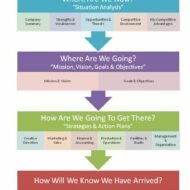Posted by Managementguru in Business Management, Decision Making, Principles of Management, Project Management, Strategy
on Jul 31st, 2014 | 0 comments

A goal has the word ‘go’ in it. Your goals should go forward in an unambiguous direction. However, goals are more about everything you accomplish on your journey, rather than getting to that distant point. Goals will often go into undiscovered territory and you therefore can’t even know where the end will be.

Posted by Managementguru in Decision Making, Human Resource, Organisational behaviour, Principles of Management, Training & Development
on Mar 19th, 2014 | 0 comments

How to Grade Your Employees on Their Performance Performance appraisal is the process of obtaining, analyzing and recording information about the relative worth of an employee. Organizational Development: Organizational Development denotes an overall and comprehensive development of an organization supported by the entire team of employees working for that organization. A useful technique in the management process that serves as a measure of performance and productivity is “performance evaluation” or performance appraisal. Performance refers to the degree of accomplishment of the task that makes up an individual’s job. Performance appraisal serves the following purpose: To assess the present levels of employee performance. To understand the future needs in training and development based on the strengths and weaknesses of the employees. To provide feedback on their performance. Serves as a basis for reward allocation, such as, increase in pay scale, promotions and many other decisions like, confirmations, transfer, demotion etc. , Establishes performance standards and offers scope for improvement. Acts as a motivational tool for workers to perform better. Checks and facilitates employees who exhibit poor performance. Also assesses behavioral pattern of the employees. People who work for big corporate companies identify themselves with the objectives of the company and expect feedback, either in the form of a compliment or criticism. Compliments act as morale boosters to perform better and criticism though initially might puncture the ego, induces the potential to perform, to prove oneself. Managers should never be reluctant on their part to appraise subordinates on the job expectations and demands. In an activity as important as managing, there must be no pitfalls to measure performance as accurately as possible. The Appraisal Process: The next important aspect in the appraisal process would be deciding the content to be appraised. Individual task outcomes where performance is evaluated on the outcomes delivered by the individuals, evaluation of personal characteristics and traits or behavior are done to rate the employees as to where they stand in terms of performance. Appraisal Techniques: The widely used managerial technique in the appraisal process is evaluating performance against verifiable objectives, which truly makes sense, because the employees would be blind folded if they don’t have the right direction to proceed. Evaluation can be done in a comprehensive, periodic or continuous fashion. It all depends on the nature of work done, company practice and other situational factors. Say, for instance, performance review can be done after the completion of a major project, that makes sense, doesn’t it? Periodical reviews: Formal reviews can be supplemented and supported with frequent and short informal reviews, for the superior- subordinate relationship to prosper and to keep communication channels open. All said and done, performance review based on verifiable objectives, although gives better vision and clarity, doesn’t allow the manager or subordinate to grow individually. It does not help in personality development, the emphasis ever being focused on accomplishing the operating objectives. The 360 Degree Apparaisal: The latest approach of performance evaluation is the 360 degree appraisal that well suits the managerial cadre. It provides for performance feedback from the full circle of daily contact, that a manager might have, ranging from customers, peers, subordinates, boss etc. , This also fits into organizations that have introduced teams, employee participation and total quality management...

Posted by Managementguru in Business Management, Human Resource, Organisational behaviour, Principles of Management, Training & Development
on Mar 18th, 2014 | 0 comments

Self Appraisal-Amuse Yourself What is Self Appraisal: Self evaluation process involved in determining the level of self efficacy . By and large, corporate companies go for a one tier system of appraisal-where the supervisor generates a confidential report about his subordinates as and when required. This serves as a basis for the management to decide on increments or promotion for the respective candidate. But the question is, is this system fool proof? Definitely not. There are certain lapses that deserve mention and the management has to design suitable appraisal formats to improve or strengthen the weak areas. Purple Minimalist We Are Hiring Project Manager Poster by managementguru.net Some areas where the appraisal process can take a deviation: A biased report given by the appraiser due to various reasonsPerception of appraiser may be wrongThe appraiser sees the appraisee through his ideas and not from the management’s view point, which may lead to clash of ideas where the appraisee is made the victimFlaws in the design of the appraisal process where the top management may not come to know the real need of the appraiseeAppraisees sometimes don’t identify themselves with the organization and its objectivesAppraisees may not know what kind of behavior traits is expected of them by the management So it is imperative on the part of the management to introduce self appraisal process in its agenda, where the appraisee himself becomes the appraiser. This helps the organization to accomplish its overall objectives in a short time through a high performance system. This kind of appraisal by ‘oneself’ makes each and every employee to clearly understand where he stands against the expected scale of behavior. 7 ways to be professional at work Two-tier system as we may call it will help in the following manner: Participative approach infuses a sense of belongingness amongst the workforcePotential of the appraisee can be brought outThe real problem of the employees is knownHigher level of approach or interest to know or evaluate one’s own behavior is seen. Basically, organizations must examine their assumptions about human behavior and come to a common belief about people. If they believe people are basically “bad” management might go for hiring “watch-out-look-out” supervisors, rigid disciplinary regulations, and separate facilities such as parking, dining and rest rooms. All these clearly spell out the existence of distinction between the management and workforce. If the organization comes to a common agreement that people are basically “good”, entirely the approach will be different. Every worker becomes a manager and uniform treatment is given to both the employees and managers of higher cadre. Essentially in my opinion, no organization or work society will succeed without visionaries and uniform treatment that is consistent with basic principles and ethics. It has to be understood that work attitudes and values are ultimately a company’s best competitive advantage. Note: Larsen & Toubro – Engineering major Larsen & Toubro has developed a competency matrix which lists 73 competencies-that vary across managerial levels-to measure performance and gauge developmental needs of its employees. National Panasonic – The Japanese white-goods major has developed a performance-assessment system driven by Key Result Areas (KRAs). KRAs describe performance goals-business, functional, and behavioural ones-with defined time-frames and are decided jointly by the employee and his manager at the beginning of the...

Posted by Managementguru in Business Management, Organisational behaviour, Principles of Management
on Mar 6th, 2014 | 0 comments

The Management Planning Process We have heard of “Master Plans” being structured and engineered to give astounding results that is purely systematic in approach and masterly in execution. Planning facilitates to make use of the opportunities that are available in the environment to make it to the top. Opportunity Analysis is nothing but, an awareness of the factors in the external environment; understanding of the strength and weaknesses of the organization. This is the first step of planning where we have to scrutinize the market, competition, customers’ preferences, tastes, our strengths and weaknesses. Establishing Objectives is another criterion that ensures “Where we want to be, and what we want to accomplish and when”. What are Objectives? Objectives are set for the organization and each subordinate is also entrusted with them. Objectives lay emphasis on goal setting which normally emanates from the top, but it may also originate from the bottom. Management by objectives is a great concept that involves all the employees working for the organization to be a part of goal setting and decision making. Planning Premises: Premises are “Assumptions” about the ‘environment.’ It involves identification of critical factors of the environment that affect the planning. Examples of critical factors are government policies, tax rates, business cycle development, economic indicators, economic forecasts etc. No body can precisely predict the environment factors precisely and make an accurate forecast. However one can fairly predict the critical factors required for the plan. Identifying Alternatives is very significant in a corporate business environment as every plan has got a set of alternative course of action. A reasonable number of alternatives can be developed for a plan. Evaluating Alternatives and Selecting the Best: A reasonable number of alternatives can be evaluated on the basis of the principle of limiting factor. The limiting factors may be costs, time, manpower and other resources. By applying techniques of operations research, every alternative can be evaluated. For e. g. alternative ‘A’ may benefit the organization in the short term but may be more expensive and alternative ‘B’ may benefit in the long run but may be less expensive. If one wants to earn immediate profits by spending more money he can choose alternative ‘A’. If the limiting factor is cost, he is forced to choose alternate plan ‘B’. Planning is not complete with selecting the best alternative; a set of derivative plans are developed to support the basic plan. For example an educational institution might like to own a fleet of buses, for which derivative plans for selection has to be made- training of drivers and maintenance staff are supportive plans for the main plan-procurement of buses. Developing budgets completes the planning course of action and budget is referred in financial terms and they are required to control the plans. Planning is the Prime Function: Planning is the prime function of all as it precedes all functions. 1. The objectives must be clear, verifiable and attainable. 2. Planning premises are vital to the success of planning as they supply information related to future like probable competitive behavior, general economic conditions, capital and material availability, government control etc. 3. All the critical factors are clearly and thoroughly analyzed and taken into consideration. One should be able to identify clearly the critical factors that limit the attainment of the goal. It could be costs, time, manpower or any other resources. 4. In a practical business situation, one should be clearer in identifying these factors, only then the selection of the best alternative is possible. 5. Any decision taken in a plan is valid for a particular period i.e., the plan may be short term or long-term, the commitment principle...








